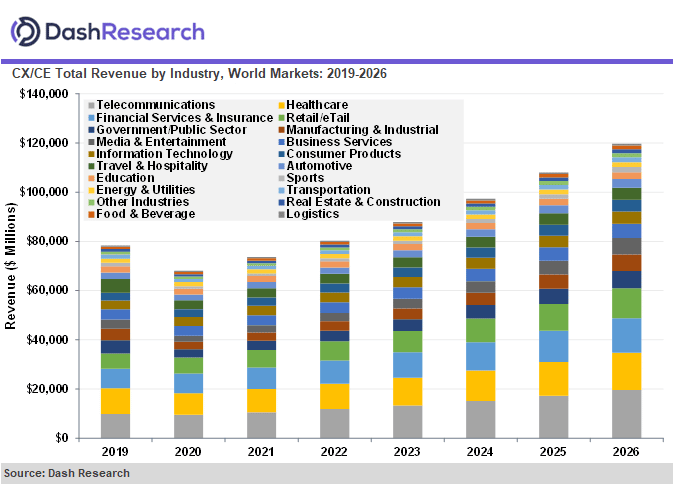Customer experience (CX) is typically defined as the sum of a customer’s experience with a product, brand, or service, encompassing all interactions before, during, and after a transaction. Providing a positive and pleasant CX is important to every business and organization, as few customers will continue a business relationship if they are treated poorly or with indifference. Moreover, according to a new report from Dash Research, CX has become the key differentiator between competitors, particularly as price and product selection have become somewhat irrelevant, due to the expansion and ubiquity of e-commerce.
“Although improvements to the overall customer experience are largely driven by organizational change management, software is increasingly being used to support these initiatives by managing and making available the plethora of customer data that is captured or aggregated from a variety of sources,” says principal analyst Keith Kirkpatrick.
Dash Research forecasts that the global market for CX and customer engagement (CE) software and services will expand to $119.7 billion by 2026, up from $78.3 billion in 2019, reflecting a 2019-2026 compound annual growth rate (CAGR) of 6.3%. This forecast represents an upgrade to Dash Research’s previous CX/CE forecast, published in 3Q 2021, due to increased estimates for market participants’ revenue, in addition to greater growth in Latin America and the Middle East & Africa.

The CX market intelligence firm projects that five industry sectors will constitute approximately 55% of total revenue during the forecast period:
- Telecommunications
- Healthcare
- Financial Services & Insurance
- Retail/eTail
- Government/Public Sector
Other industries with high growth rates between 2019 and 2026 include Media & Entertainment, Food & Beverage, and Consumer Products.
Key drivers for market growth, according to the report, are as follows:
- The reopening and refocusing of businesses in the post-COVID era
- Demand for true omnichannel communications
- Data privacy and security issues
- The increasing focus on employees
- Predictions and next-best-actions become CX drivers
- An ongoing demand to create deeper and longer-lasting customer relationships
Dash Research’s report, “CX Market Forecasts”, has been updated for 2022, and discusses the drivers and barriers of spending on CX software and services, as well as illustrating which segments and industries are likely to see the most investment over the next several years. It also includes insights into four industries that are driving the market spending (telecommunications, healthcare, financial services, and retail). A segmented list of notable software vendors is included in the report, as well as best-practice recommendations for market participants. An Executive Summary of the report is available for free download on the firm’s website.
About Dash Research
Dash Research, the market intelligence arm of Dash Network, provides in-depth research and insights on the worldwide CX market including a comprehensive assessment of technology solutions, business issues, market drivers, and end-user dynamics across industry sectors. Dash Research’s global market coverage combines qualitative and quantitative research methodologies to provide a complete view of emerging business opportunities surrounding contact center technologies, customer data & analytics, customer data platforms, customer insights & feedback, customer relationship management, personalization & optimization, and employee experience. For more information, visit www.dashresearch.com or call +1.720.603.1700.
Author Information
Keith has over 25 years of experience in research, marketing, and consulting-based fields.
He has authored in-depth reports and market forecast studies covering artificial intelligence, biometrics, data analytics, robotics, high performance computing, and quantum computing, with a specific focus on the use of these technologies within large enterprise organizations and SMBs. He has also established strong working relationships with the international technology vendor community and is a frequent speaker at industry conferences and events.
In his career as a financial and technology journalist he has written for national and trade publications, including BusinessWeek, CNBC.com, Investment Dealers’ Digest, The Red Herring, The Communications of the ACM, and Mobile Computing & Communications, among others.
He is a member of the Association of Independent Information Professionals (AIIP).
Keith holds dual Bachelor of Arts degrees in Magazine Journalism and Sociology from Syracuse University.









